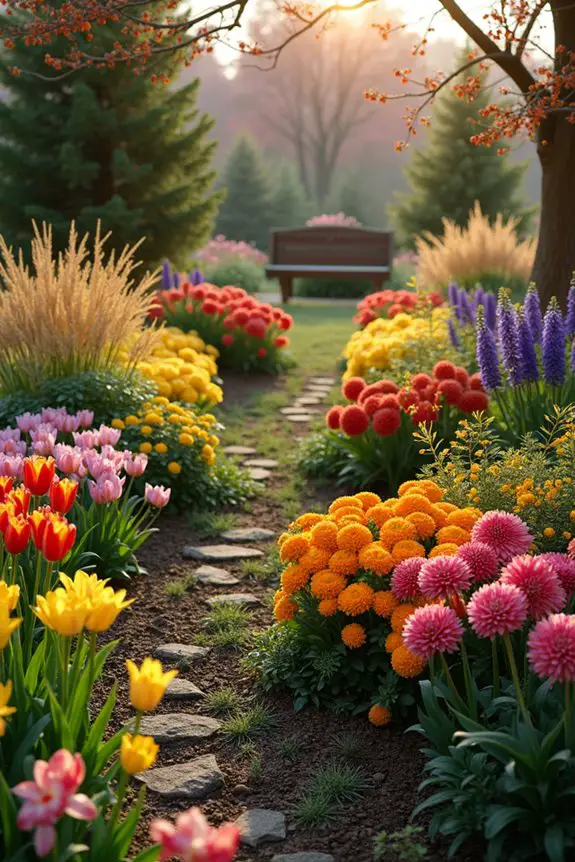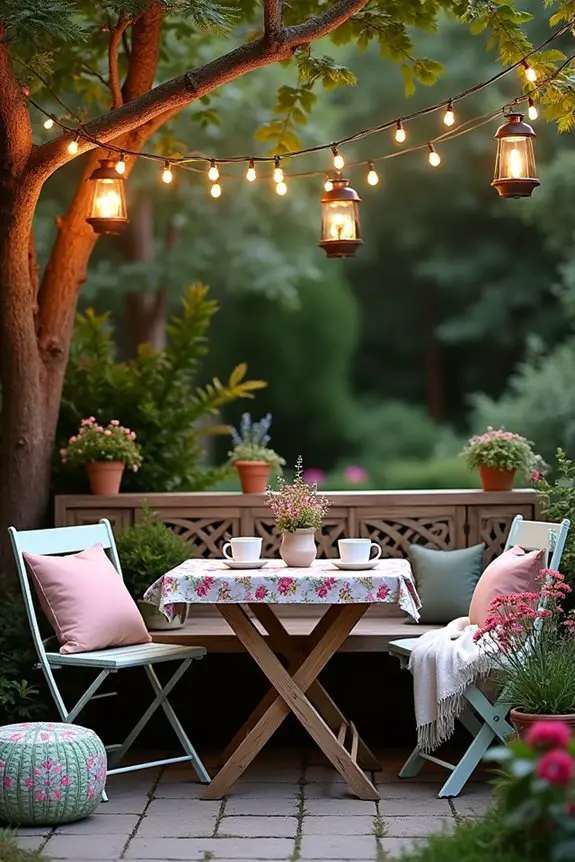A chaotic yard can feel like a disaster zone, while a thoughtfully designed garden can be a serene escape. Ever thought about how a few simple changes could elevate your outdoor space? From sleek lines to vibrant colors, there’s so much potential just waiting to be liberated. Whether you’re a gardening novice or an experienced pro, these ten ideas might just spark some inspiration. Curious how you can transform your garden without breaking a sweat?
Modern Minimalist Garden Aesthetics
When you think about a modern minimalist garden, picture sleek geometric layouts that scream style without shouting.
You’re going to want to play around with plant placements that look both intentional and effortless, like arranging pieces in a well-composed photo.
And don’t forget about that color palette—choosing the right shades can make your outdoor space sing with harmony, like a perfectly tuned choir.
1. Sleek Geometric Garden Layouts
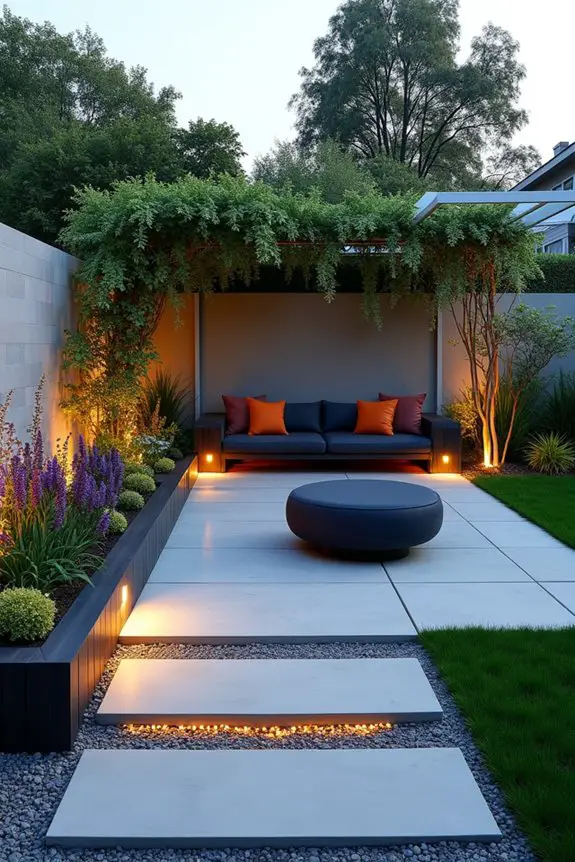
When thinking about garden layouts, sleek geometric designs truly shine. They offer that perfect mix of style and function, making a space feel both modern and organized. Imagine walking into a garden where every line and angle is deliberate—it’s like stepping into a piece of art.
Plus, these designs can easily incorporate seating areas or pathways, making them super practical for gatherings or peaceful relaxation.
So, how do you achieve this look? First off, you’ll want to define different areas with clear boundaries. Think about using gravel, stone paths, or low hedges to create distinct zones. Visualize a square patio surrounded by rectangular planter boxes—each one housing vibrant, contrasting plants that pop against the clean lines. Additionally, investing in a garden hose 100 ft can help you maintain these defined areas effortlessly.
And don’t be afraid to play with shapes. A round bench under geometric trellises brings a touch of softness while still keeping everything looking fresh and chic.
Now, here’s where it gets really fun. Imagine lighting up those geometric features at night. Integrated lighting not only adds safety but also makes your garden feel utterly magical after sunset. Picture yourself sipping tea, surrounded by soft glows emanating from the edges of your well-defined areas. Don’t you want that enticing vibe?
And don’t skimp on texture, either. Combine smooth surfaces, like polished stone, with the ruggedness of wood or metal. It’s like wearing a crisp shirt with your favorite jeans—it just works.
Consider pathways made of sleek concrete juxtaposed against lush grass or gravel. This contrast adds depth and interest to even the simplest design. Additionally, adding a garden hose water timer can enhance your garden’s efficiency and maintain its aesthetic appeal.
2. Sculptural Plant Placement Techniques

When you think of a modern minimalist garden, what probably comes to mind are clean lines and a sleek aesthetic. But let’s not overlook the magic of plants! Proper plant placement can elevate your garden from dull to stunning.
Imagine stepping out into a space where every plant has a purpose and a place, creating a vibe that’s both sophisticated and inviting.
To nail this look, start with a few statement plants. Instead of crowding the space with every plant you can find, choose a handful of sculptural species like a tall, slender agave or a spiky yucca. Introducing elements like an outdoor daybed canopy can further enhance the ambiance, making your space perfect for relaxation.
These plants stand out and maintain visual interest without overwhelming your garden. Picture them standing like proud soldiers, giving your backyard that polished feel.
Next, think about layering. No, not your clothing for chilly days; I mean layering your plants! Place those tall beauties at the back or in the center, then bring in shorter plants around them.
Consider softening sharp edges with some low-growing ground cover or trailing plants. It’s like creating a natural gradient of heights that draws the eye—but don’t worry, there’s no math required.
Now, let’s talk about harmony. Aim for a cohesive look by sticking with a limited color palette. Shades of green can mingle with a few pops of other colors—just not too many.
Too much variety can feel chaotic, like a toddler’s art project. Use natural textures and shapes to amplify that minimalist vibe. Remember, it’s all about balance, not a competition for attention.
Additionally, adding elements like a patio heater can enhance the comfortability of your garden, making it an inviting space even during cooler evenings.
Finally, don’t forget about the pathways! They’re essential; they guide visitors around your garden and provide that clean, organized feel.
Consider using smooth stones or concrete to contrast with your plants’ soft edges. It creates that beautiful juxtaposition that modern minimalism is known for, while also keeping your shoes mud-free.
3. Color Palette Selection Techniques
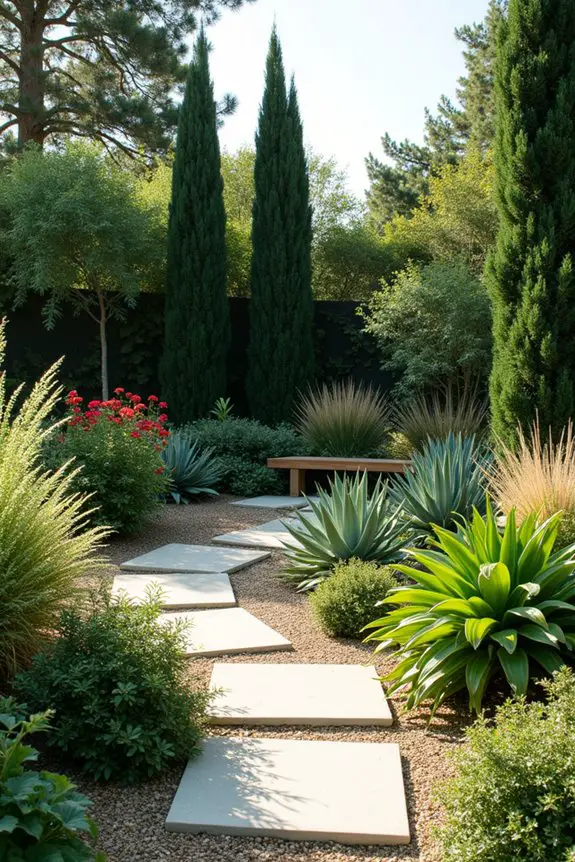
A modern minimalist garden is all about creating a serene and cohesive space, and your color palette plays a huge role in setting that mood. Think of your garden as a canvas, where every hue contributes to the overall masterpiece. A carefully chosen color scheme can transform a simple patch of land into a tranquil retreat, blending nature’s beauty with human creativity.
Start by pairing various shades of green. Yes, it might sound a bit like a “Green Party,” but trust me, there’s magic in the subtle differences. From deep emeralds to soft sages, these variations create depth without overwhelming the senses.
Add in a few pops of color, but keep them limited—maybe a bright flower or two, just to keep the neighbors on their toes. Who said gardens can’t have a bit of fun?
Now, here’s a little insider tip: consider the seasonal shifts. Selecting plants that complement each other over the months can keep your garden looking good all year long. Imagine stepping outside, only to find a gorgeous contrast between the deep reds of autumn leaves and the soft greens of evergreens.
It’s like nature’s own Instagram feed—who wouldn’t want that?
Speaking of Instagram, have you seen those stunning monochromatic gardens? They work wonders to evoke modern minimalism. Choosing one color and layering different shades and textures can create a stunningly sophisticated space.
It might sound a bit intimidating, like deciding whether to cook pasta or a fancy soufflé, but with the right planning, you’ll be serving up aesthetic delight with ease. To enhance your gardening journey, consider investing in a garden starter gift set to equip yourself with essential tools and seeds for your elegant designs.
In the end, remember it’s all about balance. A splash of color here, a whisper of neutral there—like seasoning in cooking, it’s all about making those elements work together.
4. Strategic Plant Placement Techniques
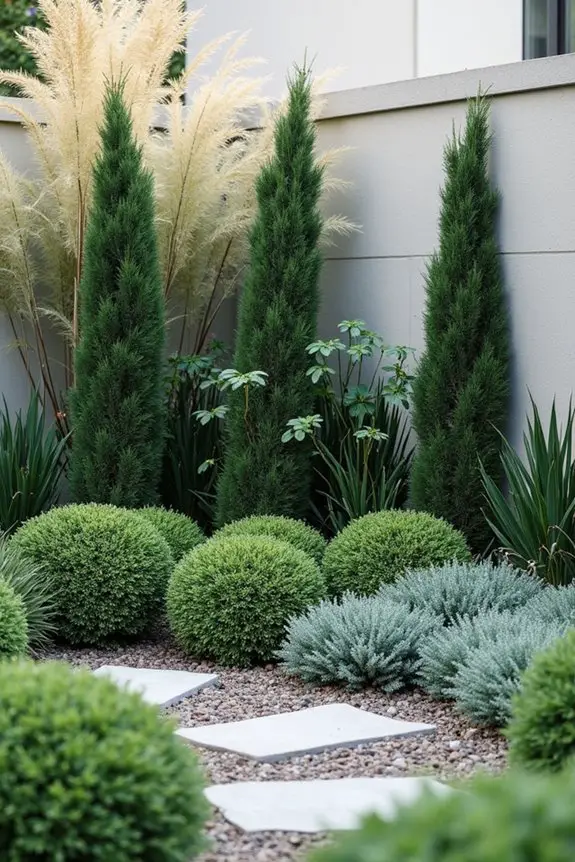
When it comes to creating a modern minimalist garden, strategic plant placement is key. It’s like making a well-balanced dish—you want to combine flavors in a way that brings out the best in each ingredient. By thoughtfully positioning your plants, you can create a visually stunning landscape that feels both serene and functional, allowing nature to shine while maintaining a sleek aesthetic.
First off, think about the scale of your garden. If you have a small space, consider grouping plants in odd numbers. Why? Well, it adds a casual vibe that feels more organic and relaxed, rather than uniform and stiff. Just imagine a trio of tall, architectural plants standing proudly beside a cluster of shorter, rounder ones. It’s like a well-rehearsed dance—each plant has its place, creating a harmonious flow.
Next, pay attention to sightlines. Plan your garden layout so that you can catch an enticing glimpse of different plant sections as you move through the space, creating a sense of curiosity. If you’re placing a stunning focal point—say, a sculptural plant or a beautiful container—position it where it can be admired from multiple angles. Think of it as plating a dish; you want to draw your audience in from every direction.
Also, consider the heights and textures of your plants. Layering taller plants at the back and shorter ones in front adds dimension and keeps everything looking well-organized. It’s like a well-stacked sandwich—no one wants to bite into an avalanche of toppings.
And don’t forget to mix in some ground cover plants to keep things tidy; they’re the unsung heroes that fill in the gaps and reduce weeds, keeping your minimalistic vibe intact.
Lastly, think about the seasons. Choose a variety of plants that bloom at different times or hold their beauty throughout the year. This way, your garden feels alive, changing alongside nature. It’s a bit like hosting a dinner party and serving a seasonal menu—fresh ingredients keep everyone excited and satisfied.
5. Texture Mixing in Plant Design
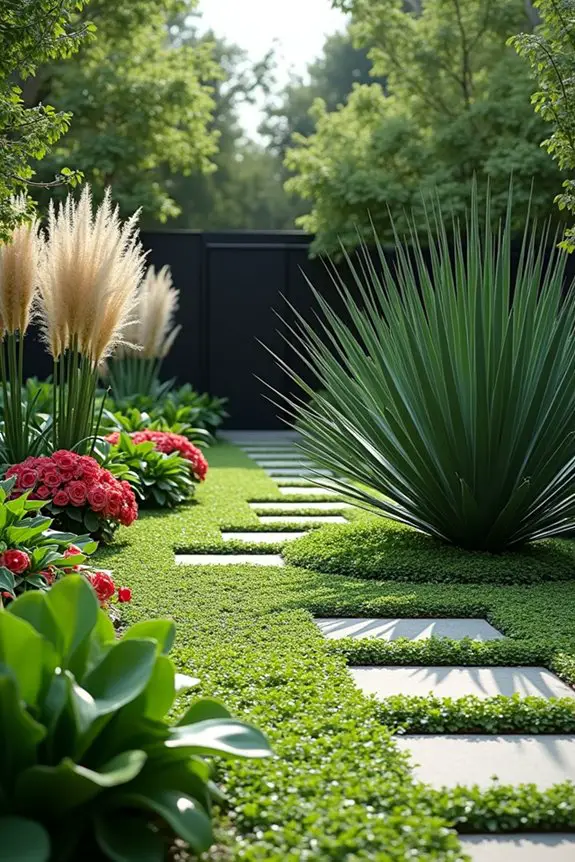
When it comes to crafting a modern minimalist garden, mixing textures in your plant design can make a world of difference. Not only does it add visual interest and depth, but it also plays to that sleek, understated vibe we all crave.
Imagine biting into a perfectly balanced dish, where each flavor complements the other. That’s what texture mixing does for your garden—making it feel more alive and dynamic.
Start by selecting a variety of plants with different leaf shapes and sizes. Think about pairing glossy-leaved plants with those that have a matte finish. It’s like contrasting a shiny apple with a rustic potato in a playful culinary dish. For instance, the smooth, elegant leaves of a hosta can beautifully underline the rough, spiky foliage of an ornamental grass. If your garden were a recipe, this would be your secret ingredient, giving it that “wow” factor.
Don’t limit yourself to just foliage—flowers can really shake things up, too! Consider incorporating plants with both delicate blooms and bold flowers for a delightful mix.
Think of it as laying out a vibrant buffet; the crunchy, colorful peppers next to a creamy dip, perhaps? Likewise, try placing a tall, striking plant at the back—like a stately yucca—behind a soft, low-growing ground cover like creeping thyme. The layering creates a culinary experience for the eyes.
And remember, don’t shy away from experimenting. Move things around, see what feels right. It’s like cooking without a recipe—sometimes the best meals come from a dash of this and a sprinkle of that.
If a combination doesn’t work, switch it up! Plants can be moved, just like I once misplaced my favorite spatula and ended up using a whisk instead. The outcome surprised me, and it might surprise you, too.
Finally, think about how these textures will combine with the hardscape of your garden. The sleekness of modern materials like concrete can provide a stunning backdrop for your lush greenery, creating that harmonious balance we adore.
Mixing textures not only brings life to your garden but also helps you embrace the minimalist ethos—less is more, after all. So go ahead, let your garden be a feast for the senses, and you just might find it’s the favorite recipe of your outdoor space.
6. Material Selection for Minimalism
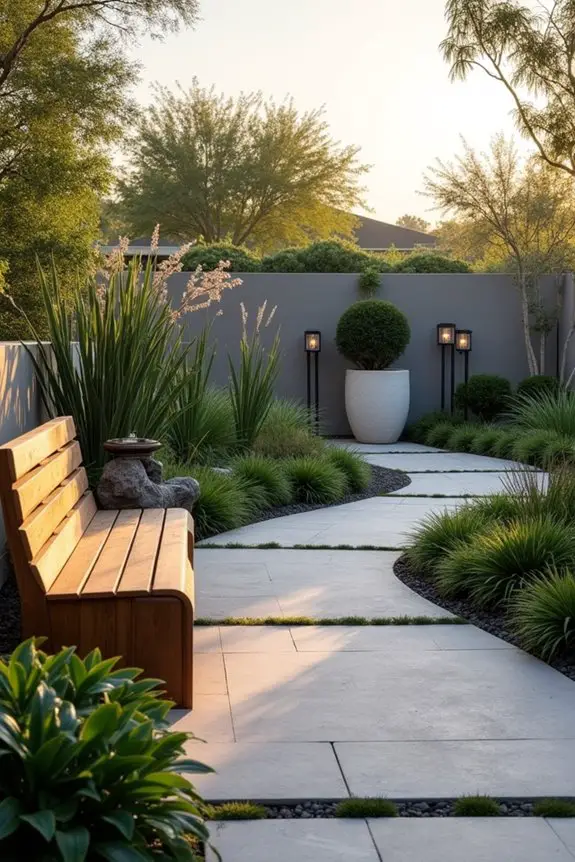
When it comes to creating a modern minimalist garden, the selection of materials can be the unsung hero of your outdoor space. Choosing the right materials not only enhances the aesthetic appeal but also sets the tone for functionality.
Think about it: sleek surfaces and natural textures harmonize to give a garden that elegant, yet relaxed vibe we all love. It’s like picking the perfect dinnerware for a fancy meal—every element plays a part in the overall dining experience.
So, what should you look for in materials? Start with a mix of natural options like wood and stone, paired with modern elements like concrete or metal. Picture a lovely wooden bench nestled among smooth gray stone pavers. It’s cozy yet chic, much like serving comfort food on a stylish plate.
Just imagine enjoying your morning coffee in a corner garden that feels both inviting and sophisticated.
And don’t forget about the power of color! Neutral tones often rule in minimalist design, providing that clean, uncluttered backdrop we seek. Think whites, creams, and soft grays.
It’s like painting a wall—those subtle hues allow the vibrant greens of your plants to shine through. Remember the time I tried to paint my living room a bold purple? Let’s just say it was a colorful disaster. Neutral colors, however, are like a blank canvas, allowing your plants to be the stars of the show.
What about those hardscapes? They can greatly impact your garden’s look and feel. Choose smooth pathways and sleek deck materials, creating a flowing movement throughout the space.
You want visitors to glide through your garden rather than stumble around—no one likes tripping over uneven stones. It’s important to keep things streamlined, just like preparing a simple pasta sauce: the fewer the ingredients, the better they shine.
Lastly, don’t overlook the finishing touches. Incorporate some metal accents or light fixtures to elevate the overall atmosphere. A simple lantern glowing softly at night can create a serene escape.
Just like a drizzle of balsamic glaze can transform a salad, those little details can turn a good garden into a great one.
7. Space Optimization Strategies

Now, let’s chat about space optimization strategies in your modern minimalist garden. This isn’t just about making the most of your square footage; it’s about crafting a cozy, open vibe that feels spacious and inviting. Much like how I try to use every inch of my kitchen counter without creating chaos, your garden can do the same—only with dirt and plants.
First things first, think vertical. Just like I stack my cookbooks to save counter space, you can add height with trellises, wall planters, or even hanging pots. Vertical gardening not only looks great—it draws the eye upward, giving the illusion of more space.
Imagine lush vines climbing a sleek wall; it’s nature’s way of giving your garden a little extra pizzazz and depth. Plus, they’re a breeze to maintain, kind of like a slow cooker that does all the hard work while you kick back and relax.
Next up, consider your layout. Open designs are your best friends here. You want pathways that guide visitors smoothly through your space without feeling cramped. Picture walking through a garden that flows naturally, much like a well-thought-out recipe—no one wants to trip over the spice rack when they’re just trying to grab the basil.
Keep furniture and hardscapes thoughtfully positioned to create zones for lounging, planting, or just soaking in the ambiance.
And what about multi-functional pieces? Just like my trusty wooden cutting board that doubles as a serving platter, your garden can be home to seating that serves dual purposes. Think benches with built-in storage that hide away tools or cushions.
It’s a practical twist that keeps things tidy, while still feeling homey.
Lastly, remember that less can truly be more. Embrace negative space—the areas without plants or furniture—to give your garden room to breathe. At my last moment of garden chaos, I crammed too many pots in the corner, turning the space into a botanical traffic jam.
Now I know that a thoughtfully placed rock or a patch of gravel can provide that perfect pause, creating a serene shift from one area to another.
8. Natural Element Incorporation Techniques
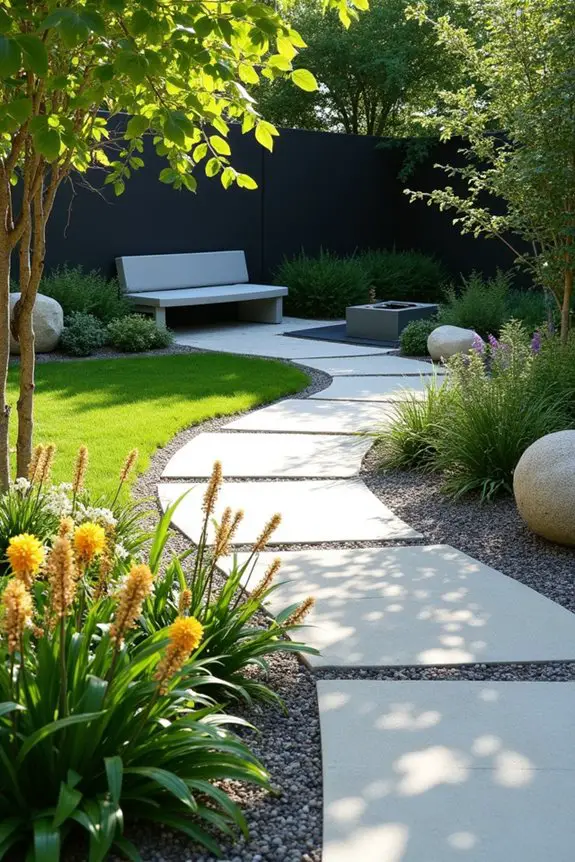
When it comes to a modern minimalist garden, incorporating natural elements is a game changer. It’s not just about looking good; it’s also super functional. Think of it like adding good quality olive oil to your cooking—it elevates everything. By bridging the gap between plants and hardscapes, you enhance visual appeal while creating a relaxed vibe that feels welcoming.
Start by selecting clean, sculptural materials for your hardscapes. Imagine that gorgeous stone path that invites you to wander, or perhaps a sleek concrete bench that’s just begging you to sit and sip a cup of tea. These materials create a sense of calm, much like how a freshly organized pantry brings joy.
Using natural textures alongside geometric shapes blurs the lines, tying your garden together beautifully.
Next, think about your plants. Go for species that are native to your area. These beauties aren’t just easy on the eyes; they thrive without too much fuss—saving you time for other things, like figuring out the perfect stir-fry recipe. By choosing plants that naturally belong in your environment, you’re crafting an ecosystem that invites local wildlife.
Picture colorful butterflies fluttering by while you garden; it’s like nature’s own cooking show live in your backyard.
And don’t forget water elements. A simple birdbath or a sleek water feature can act as a focal point, creating soothing sounds reminiscent of that gentle bubbling brook you always see in movies. It’s an instant mood-lifter, trust me. Plus, it’s a happy treat for your local birds.
Just picture yourself showcasing your triumphs to friends—“Oh, this isn’t just a garden; it’s also quite the wildlife haven!”
Lastly, aim for balance. Just as you wouldn’t drown a dish in salt, keep your elements harmonized. A big boulder can ground a garden just as a well-placed pot of herbs can enliven a kitchen.
Embrace the beauty of negative space, allowing your eyes and mind to breathe amidst all that greenery. You’ll soon find that less really does create more, transforming your space into a minimalist oasis where thoughtfulness reigns.
9. Vertical Garden Layering Techniques

When you think of a modern minimalist garden, layering your plants can elevate your space to a whole new level of beauty and functionality. Imagine flipping through a cooking magazine and finding a mouthwatering layered dessert; that delightful contrast and texture is what vertical garden layering does for your outdoor oasis. It creates depth and interest, making the garden feel alive and dynamic, much like those taste sensations that keep you coming back for more.
To start, choose a variety of plants that can thrive in different heights. Think tall grasses that sway in the breeze, medium-sized shrubs that provide a lush backdrop, and delicate ground covers that elegantly drape over the edges. It’s like building a culinary masterpiece. You want your tallest “ingredient” at the back, just like how you might stack the tallest layer of a cake first. It creates a visually appealing balance, guiding the eye throughout your space.
Don’t shy away from using containers, either. They can act like the playful toppings on your dish. Imagine hanging planters filled with cascading flowers or unique succulents. These vertical elements draw the eye upward, making your garden feel grander, even in smaller spaces.
But let’s be real—when I tried this in my own backyard, I might’ve gone overboard and created a mini jungle. It sounded great in theory until I was tangled up in climbing vines during a “quick” watering session. Take it from me; moderation is key, much like when adding chili flakes to your pasta.
Another trick? Use trellises or wall-mounted planter boxes for your plants to climb. This not only saves space but adds an element of intrigue, inviting your friends and neighbors to poke their heads in for a closer look. Just try to resist the urge to blurt out, “I grew that!” every time someone admires your greens. Keep it cool; let your plants do the talking for you.
Lastly, visualize the overall harmony of your garden. Confirm that the colors and textures of your plants complement rather than compete with one another. Just as you wouldn’t serve a gourmet dish without considering how it looks on the plate, your garden deserves the same thoughtful arrangement. Embrace those contrasts—a vibrant flower next to a stark green leaf can send happy vibes your way, creating an invitation for relaxation and wonder.
Happy layering, and remember, just like a good recipe, it’s about balancing all the right flavors to create your stunning garden slice!
10. Spatial Flow Enhancement Techniques
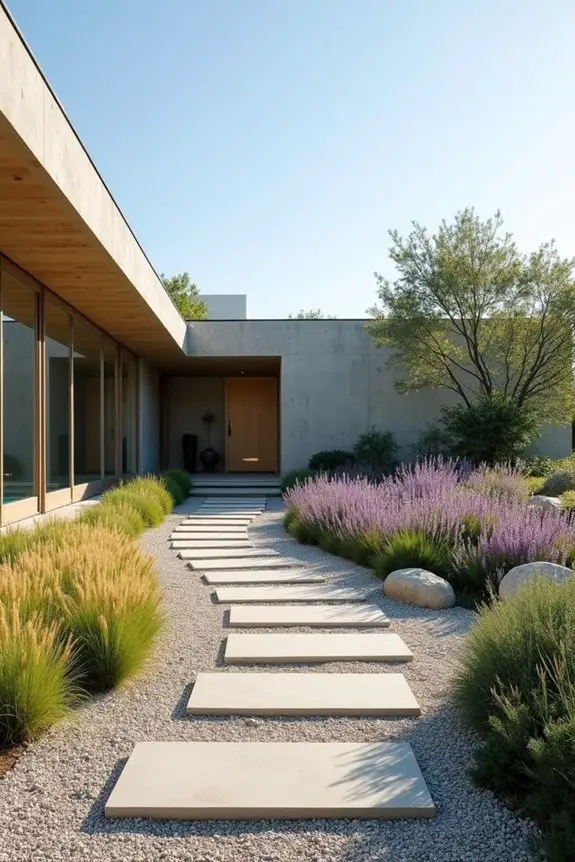
Creating a seamless spatial flow in your modern minimalist garden not only enhances its beauty but also improves your experience in the space. Think of it like a well-planned dinner party; everything flows from the appetizers to the dessert, with no awkward pauses. You want your garden to feel like a lovely stroll through an art gallery—where the pieces (or plants) complement each other and lead you effortlessly from one vignette to another.
To start, visualize how you move through your garden. Imagine clear pathways—maybe a sleek stone or gravel trail that guides you with gentle curves. That’s your garden’s way of saying, “This way, friend!” Remove any confusing twists or turns. Instead, let the layout direct you with confidence and purpose.
Try placing some low-lying plants along the edges of the path so they’ll gently frame your route. It’s like having a subtle entourage cheering you on as you wander.
Next, consider the materials you use. Pairing soft, natural textures like wood or stone with sleek, geometric structures, such as a modern bench or a simple water feature, can elevate the vibe. Picture a minimalist bench made of smooth concrete beside a rustling patch of native grasses. The contrast isn’t just eye candy; it promotes harmony and balances the wild with the refined.
“Why didn’t I think of that?” you may find yourself saying when the whole setup just clicks.
In a personal experiment, I tried using stepping stones to connect different sections of my garden. Boy, did it make a difference! Suddenly, I wasn’t just walking through a clunky yard; I was exploring a serene oasis.
But a word of caution: choose your stones wisely. I once went for oversized slabs, thinking they’d be bold and artistic. Alas, they felt more like I was traversing a quarry. Sticking to medium-sized ones made a huge impact without making my yard feel like an obstacle course.
Finally, don’t forget to design for the senses. Incorporate plants that engage with you visually, but also those that delight your nose, like herbs or flowers with a fantastic scent. Picture wandering past a patch of lavender, where the fragrance beckons you to linger a little longer.
It’s like passing your friend’s house where the aroma of freshly baked cookies wafts out. You just can’t resist.
Essential Gardening Maintenance Practices
A well-tended garden is like a cozy home—it thrives with a bit of love and daily attention.
You might think gardening is all about the big stuff, but it’s those small, everyday practices that really matter. Start with regular watering, especially if you’ve got new build garden ideas sprouting up.
Gardening thrives on small, daily rituals—regular watering is key to nurturing those new ideas that take root.
Weeds? Ugh, they love to crash the party, so keep them in check. Pruning dead leaves and deadheading flowers helps plants stay vibrant.
Oh, and don’t forget to feed your plants, just like how you wouldn’t skip breakfast.
Mulching not only looks nice, but it also holds moisture.
Finally, take a moment to enjoy your handiwork. It isn’t just work—it’s your serene escape, where even your plants might judge you a little less.


